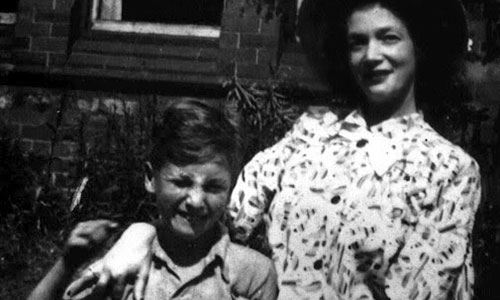Today in Tedium: 1995 was the year that Billy Corgan got in our faces and shouted, "Despite all my rage, I am still just a rat in a cage!" And since then, we've only gotten angrier as a society. All of our failings are tied to that inner rage that makes for good drama … but causes the most damage. Last week, uber-scientist Stephen Hawking called aggression "the human failing I would most like to correct." In today's issue of Tedium, we're on the hunt for the root cause of all this rage. No rats and no cages, however. And definitely no smashed-up pumpkins. We promise. — Ernie @ Tedium
1991
The year that Mike Godwin, a commenter on the Usenet forum rec.arts.sf-lovers, created "Godwin's Rule": "As a Usenet discussion grows longer, the probability of a comparison involving Nazis or Hitler approaches one." The rule, since then, has taken on a life of its own, overshadowing both Usenet and Godwin himself. In 2011, the term ended up in the dictionary, ensuring that it'll live forever, unlike Nazism (hopefully).

Internet mobs: when microaggressions go macro
Here's the problem with internet mobs. At some point, the person we're angry at becomes a symbol of the thing we're really fighting against. But in the process, we forget that the person is still a person.
Justine Sacco is a person who became a symbol for ironic white racism. But she's still a person whose entire life was judged by a single tweet. And that's made her a symbol again—for mob justice that's gone too far. So many thinkpieces have been written about her.
This isn't a thinkpiece about her. There are already plenty of good ones. This is a thinkpiece about the people she pissed off.
Sacco made a mistake, but really, she's just a scapegoat for what she represents. The truth is, people we don't know make really good targets for working through our microaggressions.
As the scale of our frustrations get ever-smaller and we internalize the frustrations that society throws upon us daily, they build upon each other, one by one. Eventually, they bubble over, collectively, into one whole piece.
The internet is a fireplace full of tinder—microaggressions from every direction. Liberals who feel slighted by conservatives. Conservatives who feel slighted by liberals. Gamers who think the politically correct are trying to ruin their fun. Religious people who feel slighted by atheists. People of every ethnicity and gender who feel slighted by everyone else on the internet.
We feel slighted from every direction. And when it comes to microaggressions, nobody ever believes that we're actually being screwed.
"When only a fraction of society holds the power to define what is real and what is not real, the rest of us are left living by their rules," David Rivera Ph.D. writes in Psychology Today of the way these unintentional passive-aggressive slights build up.
All it takes for that tinder to go off is someone saying the wrong thing, and someone else noticing they said the wrong thing. That's when people turn into symbols and we collectively lose our you-know-what.
They become our images for racism, or the people in our own lives who mistreat animals, or the anger we feel about a given situation, or the disrespect we feel in our lives. We want them to lose their jobs. We want them to suffer. We want them to fail.
We don't feel the consequences, because we don't actually know these people. Having solved that problem the only way an angry mob knows how, we soon forget about them.
They don't forget about us.
41.3%
The percentage of internet users that don't actually comment on posts, according to a 2014 study by the University of Manitoba. Just 5.6 percent of internet commenters say that they like trolling, but it sure as hell seems like a lot more, doesn't it?

Let's Get Primal
For every story about how the internet tears people apart that we run into—every story about the random mobs that pull lives apart—there are many more people that have been connected by the internet.
Too quickly, this element is forgotten. Here's a story about one man who helped bring a community together.
In 1970, psychotherapist Arthur Janov inspired an entire generation of people to look deep into themselves through the concept of primal therapy, best explained through the concept of The Primal Scream. For a time, the experimental treatment style—an in-depth process that encourages patients to directly confront suppressed pain in childhood—became very trendy for a time, most famously inspiring John Lennon/Plastic Ono Band, Lennon's first post-Beatles album.
"John got his copy about two weeks ahead of publication, he read it, and he came to me," Janov told Rolling Stone in 1971. "Listen to his new album if you want to know what he got out of it."
(Unfortunately, Lennon—who believed he was being dogged by immigration authorities—had to quit the therapy before it was finished, and later fell off the wagon, an 18-month period the singer called his "lost weekend." "We had opened him up, and we didn't have time to put him back together again," Janov told Mojo in 2000.)
But eventually, Janov's methods became very niche, and now are considered outside of mainstream psychology. To give you an idea of how psychologists feel about the therapy, a 2006 study of discredited psychological treatments ranks Primal Therapy below lobotomy, along with therapy styles involving dolphins and horses.
In other words, the odds are pretty good that you're not gonna find a community of Primal Therapy enthusiasts hanging out in a Starbucks in Middle America. Definitely not a Panera.
The Internet's Primal Advocate
That's where the internet comes into play. And one of the first people to really capture the power that it held for this community was a man named John Speyrer, who, in 1995 launched a website called Primal Page, which organizes the many schools of thought based on Janov's work. Speyrer's efforts helped unearth an entire community of people interested in Primal Therapy, including message boards full of people willing to do online primal sessions.
Speyrer himself wasn't sold on the therapy at first—but eventually he gave in.
"Before experiencing the process, I was completely turned off by what I had read about the primal process," he explained in an essay discussing his own process. "It all sounded so contrived and undignified!"
Eventually, he was won over and became one of its biggest advocates, writing hundreds of articles about it over the years, taking part in Yahoo groups, and discussing what draws people to the therapy—and away from it.
Speyrer died in 2011 at age 79, but his website—which remains online today—offers one of the most in-depth reflections of a single human being and his experience with Primal Therapy. (The page is now administered by the International Primal Association.)
What if we all collected our thoughts on a specific area of expertise in the depth that Speyrer did? We might get a little closer to what makes us tick—no lobotomy necessary.
“It allows the students to express themselves creatively in a meaningful and enjoyable way in their second language. The feedback in the form of ‘up votes’ or comments they receive from the online community where they are posted also adds an interactive element to the assignment.”
— Scott Stillar, an English as a Foreign Language teacher in Japan, explaining to The Daily Dot why he uses rage comics in his classes to encourage his students to learn the language. He runs a subreddit, r/EFLcomics, to encourage his students to write in English. Rage comics, which originated on 4chan in 2008, are an effective way of simply explaining a range of emotions. And yes, there's a range. Just check out this Know Your Meme chart if you don't believe me.
I don't claim to be an expert at all this. I'm just a guy who's seen the ebbs and flows of a lot of random crap on the internet. But I think that the internet has a way of finding our trigger points, the things that piss us off on a daily basis, and putting them in front of us. Journalism is a great example of this in action: We don't read the news to get a smile. We read it to get pissed off.
"Many studies have shown that we care more about the threat of bad things than we do about the prospect of good things," psychologist and executive coach Ray Williams wrote in Psychology Today back in November. "Our negative brain tripwires are far more sensitive than our positive triggers. We tend to get more fearful than happy. And each time we experience fear we turn on our stress hormones."
Back in December, Gawker's Sam Biddle wrote that he went after Justine Sacco because "Twitter disasters are the quickest source of outrage, and outrage is traffic." If only the two weren't so closely connected.




